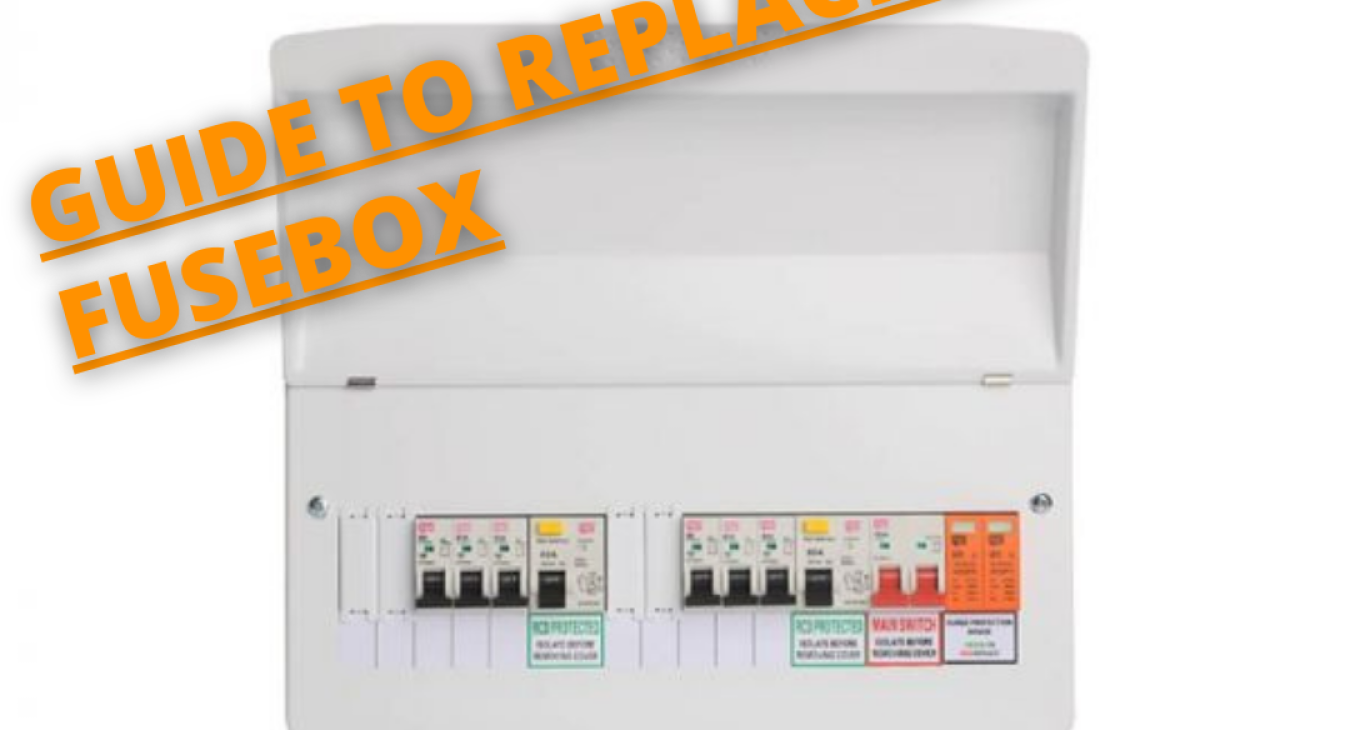Before replacing a consumer unit, it is worth noting that an old fuse box is neither illegal nor inherently dangerous. Industry standards are changing all the time and an older fuse box likely met the relevant standards when it was installed. As long as you are safe and the fuse box is still capable of meeting your energy needs, there is no need to worry about an upgrade.
Having said that, just because you don’t need to worry about an upgrade doesn’t mean you shouldn’t consider it. Consumer units are a lot better at protecting us than their older counterparts.
In this guide, we cover:
- The difference between a fuse box and a consumer unit
- Signs to look out for that indicate you should replace it
- The process of replacing a consumer unit
- The regulations that affect the job
- Frequently asked questions about replacing a consumer unit
WHAT IS THE DIFFERENCE BETWEEN A FUSE BOX AND A CONSUMER UNIT?
A consumer unit and a fuse box are technically the same. They both refer to the device responsible for controlling and distributing energy throughout the house and protecting the residents from electrical failure. A consumer unit is simply the modern equivalent of a fuse box.
That said, there are two, key differences.
When a fuse box ‘trips’, the fault or overload current flows through the fuse wire causing it to become hot and melt. The melted fuse breaks the circuit and disconnects the energy supply. A consumer unit, on the other hand, uses circuit breakers. These are automatic protection devices that switch off a circuit if they detect a fault.
The first difference concerns the restoration of power. A consumer unit simply requires you to switch the power back on, while a fuse box requires you to replace the melted fuse before the power can be restored.
The second difference is the level of protection. Fuses take one or two seconds to break a circuit compared to a consumer unit which takes milliseconds – the length of time before the risk of electrical shock is present.
DO I NEED TO REPLACE MY CONSUMER UNIT?
A fuse box only needs to be replaced if it poses a danger to your health and safety. If you’re concerned or unsure, arrange for an electrician to come out and check your installation. Our guide on Electrical Installation Condition Reports will tell you what you need to know.
However, we’ve drawn up a list of things to look out for and consider:
- You have a fuse box instead of a consumer unit: A fuse box is simply the older version of a consumer unit. The key difference is that a fuse box uses fuses instead of circuit breakers. So, when a fault occurs, the fuse wire melts to break the circuit and prevent harm. This process takes longer than a circuit breaker (which consumer units have) and requires the melted fuse to be replaced before the power can be restored. Most fuse boxes are no longer compliant with safety standards or suitable for modern life.
- Your consumer unit is more than 10 years old: Consumer units become worn and ineffective with time and use, so it’s always worth checking how yours is coping. What’s more, regulations on electrical safety are changing all the time so there’s a chance your unit isn’t compliant. While this isn’t a reason to change it, it does mean that it may not be the safest option available to you.
- Your consumer unit doesn’t have RCDs: Residual current devices are life-saving devices designed to protect against fatal electric shocks or fire. The IET regulations require most, if not all, circuits in domestic premises to be RCD protected.
- There is visible damage or deterioration on your unit.
- Your unit keeps tripping.
- Your lights are flickering, or your sockets are unresponsive.
- You’re having major work done (e.g., a full-house rewiring).
If you notice one or more of these, it is a good idea to organise an inspection. There’s no harm in being cautious.
The fact is consumer units are a lot better at protecting us than their older counterparts. Not only are they designed using modern technology, but they’re subject to updated industry standards which require further protective measures. Under the IET Wiring Regulations BS761:2018, new consumer units are required to:
- Be manufactured from non-combustible material: All new electrical installations must have a metal-clad consumer unit or metal-clad casing. The purpose of this is fire safety. Metal is better at containing a fire, minimising the spread of fire and removing any additional source of fuel for the fire (e.g., plastic).
- Have additional protection through a Residual Current Device (RCD): RCDs are specifically designed to protect people from electrical shock and are thousands of times more sensitive than circuit-breakers or fuses.
Fuse boxes do not have RCDs and many are made out of plastic. An upgrade is therefore a long-term investment that will pay for itself in value.
WHAT DOES REPLACING A CONSUMER UNIT INVOLVE?
- Step one of the pre-replacement is a visual inspection. This is a basic check of your house to establish the overall condition of your existing installation and identify any visible signs of damage.
- Next is an inspection of your earthing and bonding arrangements, as well as your meter tails. The aim is to make sure they comply with the relevant regulations. If they don’t or are unsafe in any way, the job can’t go ahead and remedial work will be required.
- On top of this, an electrician should ideally conduct an EICR during this stage. This will highlight any issues that could not be identified during a visual check and establish the urgency of any problems.
- If the inspections turn up any faults that will impact the functioning of the consumer unit, these must be fixed before the replacement can go ahead. This brings us to the final step of the pre-replacement – remedial work. This could be minor or major tasks and an electrician will discuss the cost and process with you.
Once the tests and remedial work are out of the way, the actual replacement can begin. This involves removing the existing unit and replacing it with the new one. Once the new unit is installed, the electrician will conduct yet another series of tests. The purpose of these tests is to make sure everything is in working order and meets the relevant standards. Finally, you’ll receive an Electrical Installation Certificate and Building Regulations Compliance Certificate as evidence the work is compliant.
ARE THERE ANY REGULATIONS I SHOULD KNOW ABOUT WHEN REPLACING A CONSUMER UNIT?
Under Part P of the Electrical Safety Building Regulations (for England and Wales), the replacement of a consumer unit is notifiable work. This means you either have to tell your local authority building control about the work (before it starts) or hire an electrician who is registered with a government-approved Part P scheme.
It also means that you need:
- An Electrical Installation Certificate to confirm that the work meets the IET Wiring Regulations
- A Building Regulations Compliance Certificate to confirm that the work meets the Electrical Safety Building Regulations
The same rules apply in Scotland but are covered by the building standards system.
The benefit of hiring a Part P-registered electrician – aside from experience and credibility – is that they can self-certify the work and provide you with the necessary certificates at the end of the job.
Failure to certify your installation and obtain the necessary documents can result in the local authority forcing you to have the work removed or altered, as well as a hefty fine.
FREQUENTLY ASKED QUESTIONS
Below we cover some of the frequently asked questions about having your fuse box replaced with a consumer unit or your consumer unit replaced with a new one.
Can I change my consumer unit myself?
No, you can’t. Changing a consumer unit is a demanding and dangerous job that requires specialist knowledge. Moreover, both the installation and the tests are governed by industry regulations, the likes of which are long and constantly changing. A registered electrician is required to make sure the work meets the necessary standards.
How long does it take to change a consumer unit?
It varies depending on the specifications of the job. A standard replacement with little to no remedial work takes between four and eight hours on average. This includes tests and fault-finding.
Will I have power during a consumer unit replacement?
No, your power will be switched off for the duration of the job.
Do I need to contact my energy supplier before replacing my consumer unit?
That depends on if you have an isolator or not. If you do, your electrician will be able to isolate your electricity supply from your end. If not, you’ll need to contact your supplier to switch off your electricity while the work is underway.











